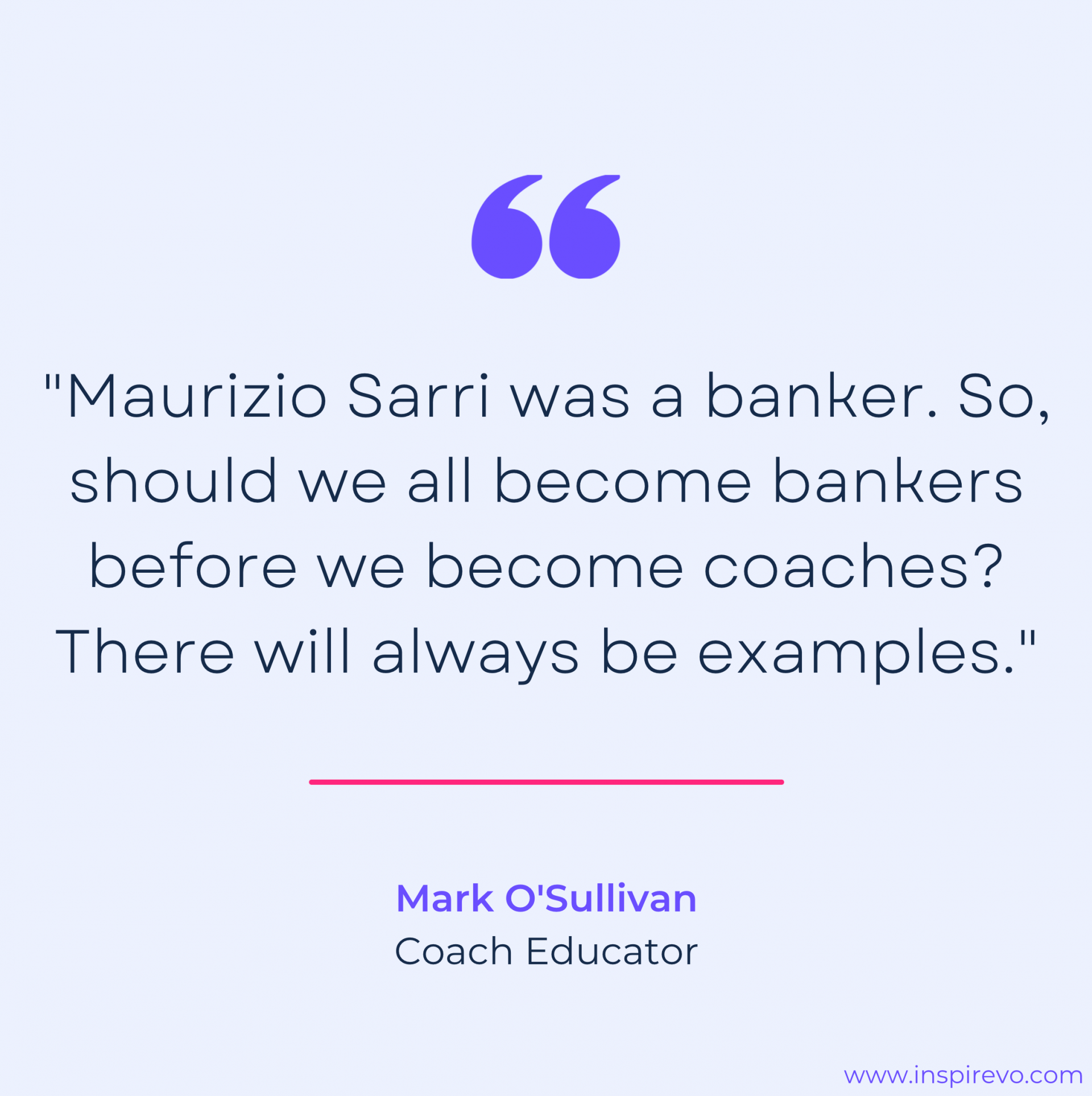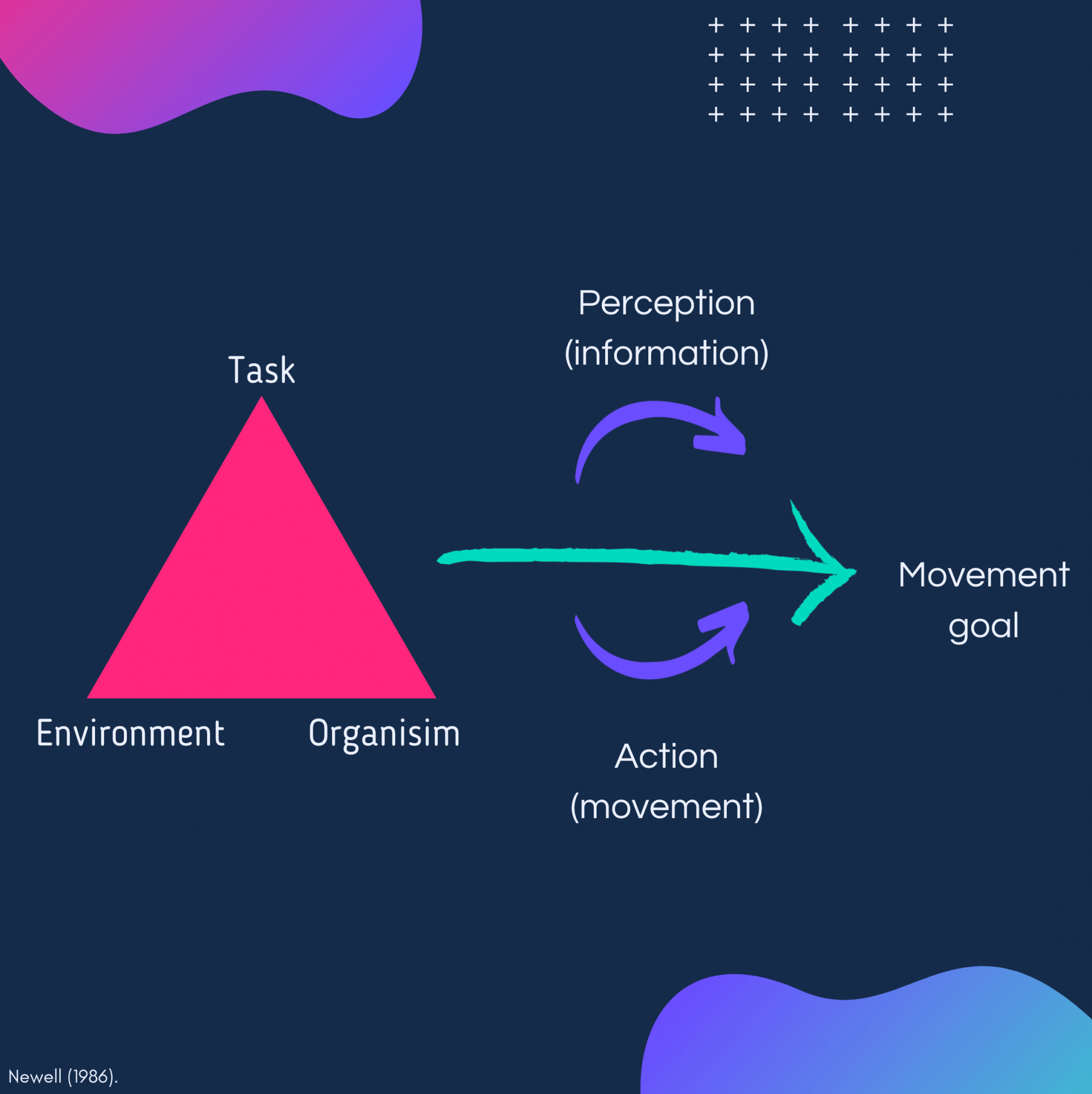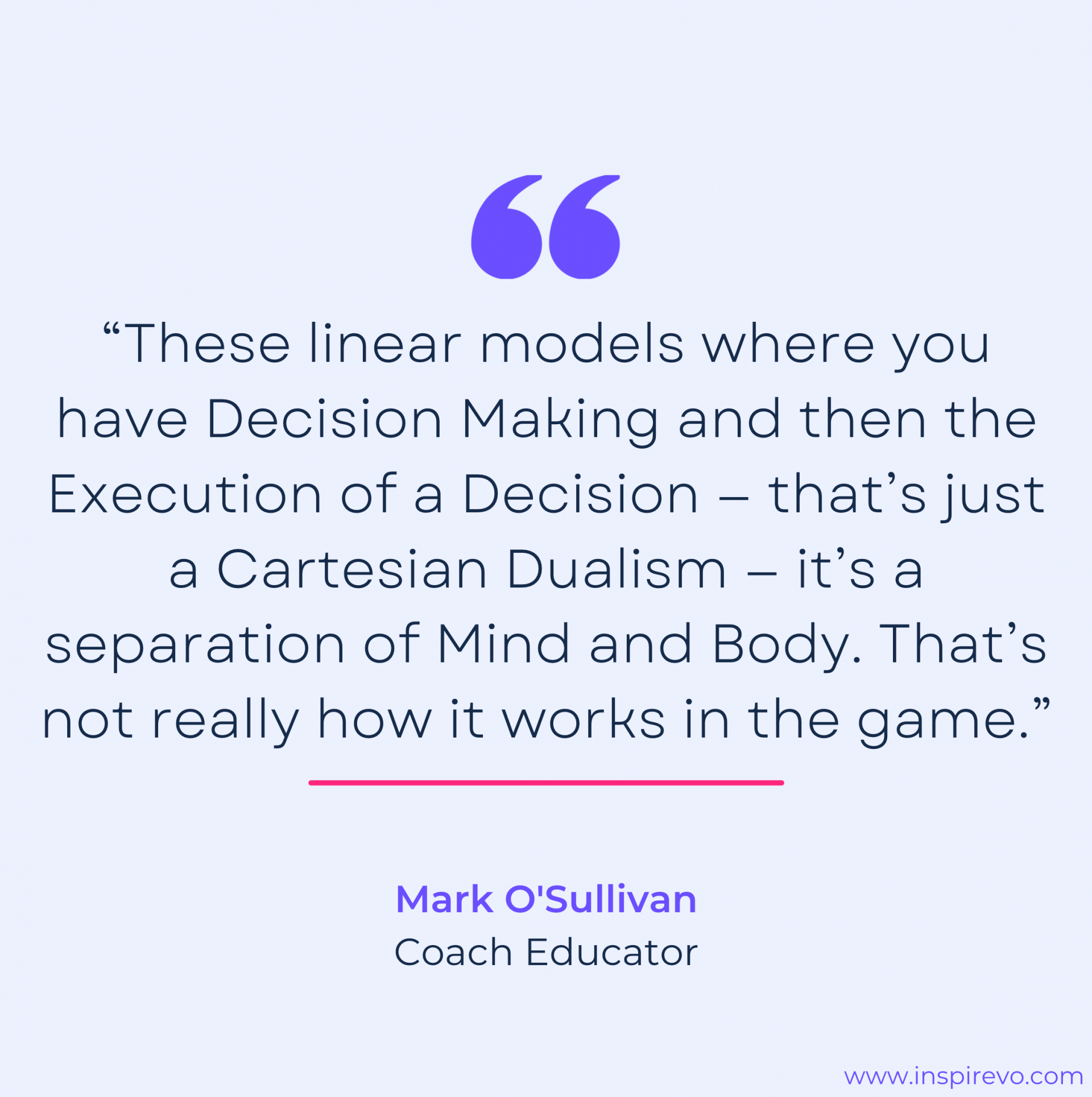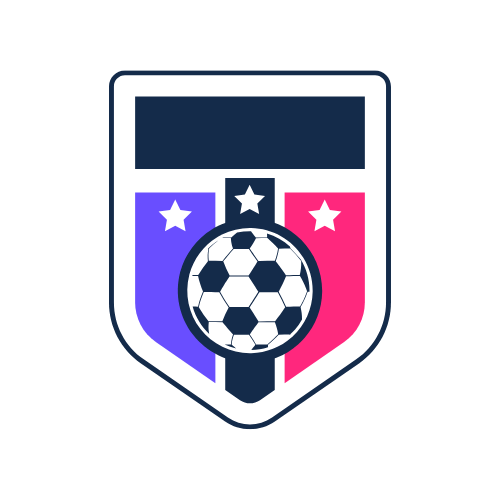Write your awesome label here.
Decision Making, Dualism,
and Descartes
The best of the just kickin' it podcast | series 01 episode 04
In this episode, Mark discusses decision making, dualism, and Descartes
Discussion Points Include:
About Guest
Transcript - Click to expand
Text
.
.
Podcast Notes
Introduction
Learning is Non-Linear
Mark feels this is the most fundamental concept that coaches and organizations fail to understand
“They fail to understand the non-linear nature of human development.”
To understand what this means, Mark asks the listeners to recall how their children learned to walk. “If you have multiple children, did they both learn to walk on the same date & time — 11 months, 3 days, and 2 hours on a Tuesday.”
This example goes to show you that, “Human’s begin things at different stages.”
He poses the argument that maybe we should start coach education courses with an education about the human learning process rather than straight into information about the game.
He believes we take this same misinformed linear approach to coach education. Education is not a linear process where you learn A, then B, then C, then D. “Where are the opportunities for genuine reflections?”
He also criticizes how coach education delivers theory. “They tell you how to plan — first you set up this, then you address the kids like this, then do this, and that, these are your questions, etc. It’s so prepared that you lose the actual feeling for coaching — the personal characteristic.”
Survivorship Bias

A lot of coaches today will cite ‘successful’ coaches as evidence to validate certain methods. For example, the success of Bobby Knight, former Indiana University Basketball Coach, could be used as evidence to validate the top-down, command style, authoritarian, ‘macho’ coaching style
Mark’s response invokes a concept called “Survivorship Bias” — “there were thousands of other coaches that coached like he did and failed.”
“We can’t throw a carton of eggs at the wall, grab the egg that didn’t break, show it to the world and say ‘look, the system works’”
“Talent is the graveyard of evidence. Nobody see’s the dead bodies.”
Mark makes a great counter-point to the claim that we should be imitating the ‘best coaches’. “Maurizio Sarri was a banker. So, should we all become bankers before we become coaches? There will always be examples.” The important thing to keep in mind is that that’s what a certain club did, or a certain coach did, in a very particular context, in a very particular culture, and in a very particular time. We can’t extract universal truths from particular situations.
We need to be more vigilant against people, organizations, clubs, and companies trying to sell their product, methodology, or book on the basis of survivorship bias. We need to ask to see the dead bodies.
Hollywood Coaching
He believes that more coaches have been influenced by Hollywood movies than they have coach education courses. Some of our conceptions of what coaching is are seriously deluded.
It would be interesting to go through all of the Hollywood movies and take not of the various coaching personalities manifested and how those have played out in the real world.
Constraints Led Approach

At AIK, the Swedish Club he works at, they follows the Constraints Led Approach, which embraces the role of non-linearity in the learning process. “We used to have coaches [at our club] that would say, ‘hey, that’s the 3rd pass you missed, what’s going on? I taught you how to pass last week!’ We worked on this all week!”
They now focus on what is holding a player back (rate limiter) and how they can manipulate constraints to help the player coordinate a functional movement under the various task constraints
There are 3 main constraints:
1. Individual — constraints on the physical/psychological characteristics of the individual player that can change over fast/slow time scales.
a. Slow to change = Height, weight, body composition, muscle architecture.
b. Change Rapidly = motivation, emotions, anxiety, etc.
2. Environment — Physical properties external to player (culture, ambient light, playing surface, societal expectations, historical, media, etc.)
3. Task — goal of the task that is more specific to performance (rules, space, position, etc.)
“These constraints help me understand the non-linearity of player development.”
He tells the story of two children, one growing up with a single mother on the 31st floor of an apartment building who is watched by his grandmother all day and another growing up on the 1st floor with an older brother and sister that play football with him all day.
Traditionally, clubs will apply a selection process and you know which player will be selected out, but the point is that, “each player that turns up to your sessions arrives with a whole bibliography of opportunities and experiences of skilled behavior that they have been afforded. We don’t know who will be a better player in 5 years.”
Decision Making

We need to stop treating player’s brains as if they are information processing devices akin to computers.
“These linear models where you have Decision Making and then the Execution of a Decision — that’s just a Cartesian Dualism — it’s a separation of Mind and Body. That’s not really how it works in the game.”
Players make decisions in the game by being adapted [attuned] to the environment. “It’s not, ‘Oh, I need to think about what I should do — maybe I’ll make this decision, or that decision.”
Perception in the game is “more direct” — our brains are not computers.
His goal is to help players develop an understanding in the game, rather than of the game. “Just because you have an understanding of the game, doesn’t mean you can play the game.”
“We should be trying to help kids develop an understanding in the game, not of the game. Of course, there is nothing wrong with talking about the game after, like ‘hey guys, did you notice what the opponent was doing?’ That’s different, but all the decision making is still in the game.”
When would Mark step in? “When it is a behavior that is repeated, then you can step in because you understand why the learner is doing something.”
He views the role of the coach as educating the attention of the players to the information. “Guiding their attention — that’s what you’re doing.”
Learning Design
He makes it clear how important session design is. “In your session design, the first feedback comes up to the player from the design.”
He says, “you haven’t made a decision until you have executed it.” Players don’t theorize in the middle of a game, so the decision and the execution are nested inside of one another. We don’t perceive and then act, we perceive-act.
“The design is where the feedback comes from first, then based on how they act you just ‘nudge’ them.”
How they act in response to the design is when you go in as a coach and start “nudging”.
According to JJ Gibson (1979) — “The environment is rich in information. We act on information and when we act on information we get new information and then we act on that. That’s what we mean by Perception-Action.”
He says, “you haven’t made a decision until you have executed it.” Players don’t theorize in the middle of a game, so the decision and the execution are nested inside of one another. We don’t perceive and then act, we perceive-act.
“The design is where the feedback comes from first, then based on how they act you just ‘nudge’ them.”
Principles
1. Representative Learning — Are what the players doing and feeling representative of the game. Negative Example: If you say everyone has to touch the ball before being able to score, that’s not representative of the game because the goalkeepers positioning provides information. “If the goalkeeper goes for an ice-cream in the middle of the match, why would everyone have to touch the ball? You aren’t educating their attention in a game like that. You don’t want their behavior to organize around the rule, but around the relevant information in the game.”
2. Repetition without Repetition (Movement Variability) — Repetition with variation in movement solutions. “You never make a pass in exactly the same way, so maybe training should reflect that?”
3. Keep Perception-Action Coupled — Session design should reflect aspects of the real game
4. Promote an external focus of attention — get players to focus on the information (external focus), not what they are doing (internal focus). Too much of an internal focus of attention, like a specific passing technique, breaks down under game pressure.
In possession: Search, Discover, Exploit space and gaps. (Football interactions that emerge: Dribble, drive, pass, shoot, movement without ball)
Recovering the ball: Close space, minimize possibilities for opponent’s football interactions and win the ball. (Football Interactions that emerge: Press, tackling, movement without the ball)
Examples
This exercise was born out of Mark’s observation that the players were struggling building out when facing their own goal.
This task is designed to help players to implicitly understand the value of concepts such as width, depth (forward and back), ubication (body profile and position) and how to direct the young players attention to information to utilize gaps/space.
Competition
Mark hypothesizes that competition within a team, or youth academy, is toxic for player development within a club/team.
Rivalry/competition causes players to overemphasize old behaviors and copy what has worked in the past. Instead of iterating and improving, they rely on what they can already do in the hopes of outcompeting their (perceived) rival in the team.
Why do we encourage players to compete with each other for selection? It’s not clear why they should be competing/fighting since they have nothing to fight about. In fact, they need to collaborate to win the game.
Inside of team’s that worships competition, players become obsessed with competition for the sake of advancement within the team. Amid all the drama that is created, players can lose sight of what really matters and they focus more on their rivals instead.
Take two players as an example. Instead of prospering independently, they compete aggressively and place their focus on each other.
The result? Both players become so focused on competing against each other that a 3rd player overtakes them both.
Rivalry/competition causes players to overemphasize old behaviors and copy what has worked in the past. Instead of iterating and improving, they rely on what they can already do in the hopes of outcompeting their (perceived) rival in the team.
Competition can also make players hallucinate opportunities where none exist.
Competition is more useful within an individual, not between individuals (within a team). As Jordan Peterson says,
“Compare yourself to who you were yesterday, not who someone else is today.”
“Compare yourself to who you were yesterday, not who someone else is today.”
Planning a Session

He doesn’t plan themed sessions. He plans from the principles of the game:
In possession: Search, Discover, Exploit space and gaps. (Football interactions that emerge: Dribble, drive, pass, shoot, movement without ball)
Recovering the ball: Close space, minimize gaps and possibilities for opponent’s football interactions and win the ball. (Football Interactions that emerge: Press, tackling, movement without the ball)
In possession: Search, Discover, Exploit space and gaps. (Football interactions that emerge: Dribble, drive, pass, shoot, movement without ball)
Recovering the ball: Close space, minimize gaps and possibilities for opponent’s football interactions and win the ball. (Football Interactions that emerge: Press, tackling, movement without the ball)
The above principles are The What, but The How is up to the players.
“You design around the principles of the game and then from there you can ‘nudge’ certain things in your design. It’s their sport [the players], they own the game, and you are there to just guide them, nudge them, and help them.”


